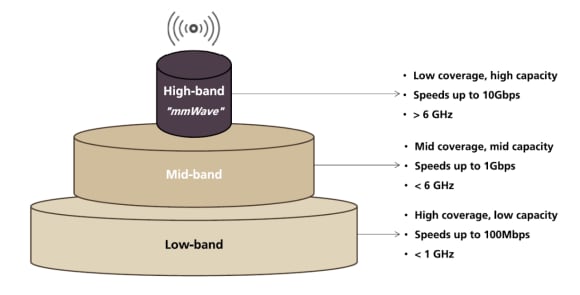5G coverage vs. capacity
CIO Global Blog
After coronavirus, 5G continues to be the No. 1 topic advisors ask us about, and a particular focus area we spend time on is defining coverage versus capacity. It is important to understand the difference when thinking about how 5G will impact consumers and how it is marketed. Put simply, coverage refers to the area where a device can obtain network access. Capacity refers to the amount of traffic a network can handle, and its corresponding speeds.
Spectrum bands, or the wavelengths used to carry data across the network, are often thought about in three "bands" (Fig. 1).
Fig. 1: Spectrum band illustration
Fig. 1: Spectrum band illustration

Low-band spectrum offers the widest coverage, penetrates walls well, but has relatively low capacity, and peak data speeds top out around 100 megabits per second (Mbps). The 4G LTE smartphones used by the majority of consumers in the US utilize low-band. People rarely have issues connecting to a 4G signal across the country or in the middle of an office building. However, carriers are actually running out of LTE capacity in a number of cities, which leads to consumers experiencing slowdowns during peak hours of the day.
Mid-band spectrum does not penetrate walls or buildings as well as lowband but provides higher capacity and lower latency. Speeds hover around 1 gigabit per second (Gbps).
Finally, there his high-band spectrum, or "mmWave." High-band offers speeds up to 10Gbps with extremely low latency but has very limited coverage and poor wall penetration. Use of high-band relies on an enormous number of small cells—these are low-power base stations that aid in expanding coverage and penetration—strategically placed throughout a city.
5G will use all three spectrum bands to offer comprehensive coverage and capacity. For example, T-Mobile, a large owner and user of low-band spectrum, is the first to claim coast-to-coast 5G network. On the other side, Verizon owns more high-band spectrum and is focused on launching 5G in urban areas, where high-band is most efficient. There are a number of spectrum auctions in the coming months and years; mid-band spectrum is currently the most sought after to help carriers increase their 5G coverage areas while providing increased capacity versus current 4G networks.
The fifth generation cellular network promises to enable autonomous driving, the massive Internet of Things (IoT), and telemedicine, among others. Higher data speeds, lower latency, and increased efficiency will all take time to be fully realized. 5G smartphones are already on the market, but in the near term the 5G network can only provide intermittent coverage, often relying on the established low-band 4G network. However, we continue to see the rollout of 5G as inevitable and investible. Please see 5G infrastructure – owning the inevitable, for more details and the stock list associated with this theme.
Author:
Author:
Kevin Dennean, CFA, Technology & Communication Services Analyst Americas, UBS Financial Services Inc. (UBS FS)
Reid Gilligan, Equity Associate Analyst Americas, UBS Financial Services Inc. (UBS FS)
